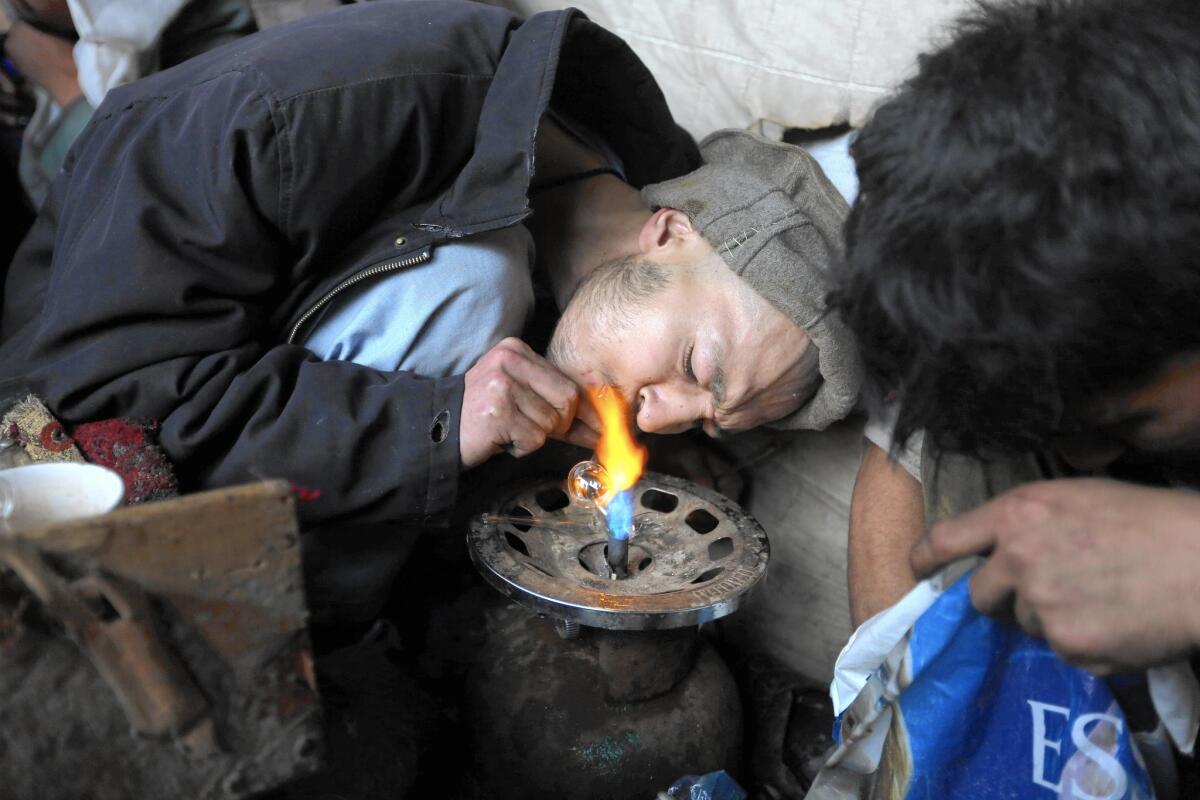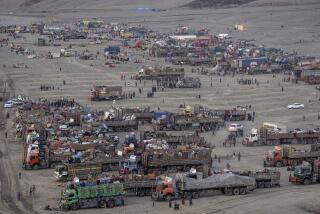New Afghan drug treatment facility helps homeless addicts get clean

Below the Pol-e Sokhta bridge on the western outskirts of the Afghan capital, hundreds of homeless drug addicts live in squalor.
The smell of human waste and smoke from opium pipes fills the air. Some people who do not live in the filth cannot resist their curiosity, so they come by to stare.
Mohammad, 24, who like many addicts would give only his first name, was born and raised as a refugee in neighboring Iran. He lived under the bridge for three years after he was deported to Afghanistan, a place he barely knew.
He says he became addicted to crystal methamphetamine while living in Iran and began smoking heroin when he couldn’t secure work or a place to live.
“I knew that living there under the bridge, through the rains and the snow, surrounded by the putrid smells of garbage sitting atop the dirt and mud wasn’t life,” Mohammad said. “It was like being an animal in the wild.”
But now Mohammad is among the first group of homeless addicts admitted to Ibn Sina, the largest drug treatment facility in Afghanistan, which has accepted more than 650 people since opening in January.
The facility, formerly known as Camp Phoenix, was one of the largest U.S. military bases during the war in Afghanistan after the Sept. 11, 2001, attacks, but has been converted by the Afghan government.
It can house up to 1,500 addicts for a 45-day detoxification and rehabilitation program, said Ahmad Fawad Osmani, director of the Drug Demand Reduction Department of the Afghan Ministry of Public Health.
The Afghan government estimates that up to 3 million people — roughly 10% of the population — are addicted to drugs, one of the highest rates in the world.
The U.S. spent more than $8 billion on counter-narcotics programs in the country during the last 14 years. But Afghan officials and experts say drug use is growing and Afghan politicians, warlords and Taliban leaders continue to rake in huge sums from the cultivation and trafficking of opium, which comes from the poppy plant.
Drug traffickers make payoffs to the Taliban to protect their farms and smuggling routes, while the Taliban generates revenue from taxing drugs that pass through areas under its control, the State Department said in a recent report.
“The cultivation, production, trafficking and consumption of illicit drugs flourish in Afghanistan,” the State Department said in its 2016 International Narcotics Control Strategy Report, submitted to Congress this month.
Khalil Ahmad, 30, a mosaic maker, said he has been addicted for eight years. He suffered excruciating pain in his job, which required him to lift tiles weighing as much as 150 pounds, and co-workers encouraged him to take a few puffs of opium to numb the pain.
Ahmad was soon hooked. As his body grew used to the high, he found himself in need of something stronger. That’s when he discovered heroin.
As was the case with many other patients at Ibn Sina, his addiction cost Ahmad his connection to his family. In the four years since he returned to Afghanistan after being deported from Iran, he lost contact with his wife and two children in the northern city of Mazar-i-Sharif. He traveled through western Afghanistan before landing in Kabul, where he lived under the Pol-e Sokhta bridge for eight months.
Laila Haidari, who runs a private drug treatment center in west Kabul, said addicts such as Ahmad are often cut off from their families primarily because of anachronistic assumptions surrounding addiction.
“Our people still don’t see addiction as an illness, they still think it’s a crime,” she said.
Halfway through the 45-day treatment program, Ahmad said he was on the path to reconnecting with his family.
“If I knew it would be this easy to get clean, I would have done it a long time ago,” he said.
Afghan officials faced challenges in converting the former U.S. Army-run training facility, which had been vacant since U.S. troops left in mid-2014 as part of the drawdown in foreign forces in Afghanistan. When the Health Ministry took over the facility late last year, officials were surprised to see that the troops had left nothing behind — only empty buildings, cracked pavement and stripped electrical wires.
“Everything was gone, we had to start at zero,” said Osmani, the Health Ministry official.
Workers had to restore the facility, rebuilding doors and fences and acquiring everything from generators to electrical poles. Occasionally, the former addicts, who were taking part in carpentry and blacksmith courses at the center, pitched in to help with the reconstruction.
The government has given the facility a $3-million budget for the first year, though Osmani said it has yet to receive all the money and much of what it has received already has been spent. Fuel and other supplies were bought on credit, he said, estimating that the center will need at least $6 million to cover its annual expenses as the number of patients grows.
Still, the center’s staff members said they were dedicated to their patients’ well-being. They look to patients such as Gholam Sakhi, 70, as proof of what can be achieved.
The bread seller had been addicted to opium for more than four decades, but he said that in 23 days at the center he had begun to feel like a new man.
“Look at me,” he said. “If I can let go of my addiction, anyone can.”
Latifi is a special correspondent.
More to Read
Sign up for Essential California
The most important California stories and recommendations in your inbox every morning.
You may occasionally receive promotional content from the Los Angeles Times.










